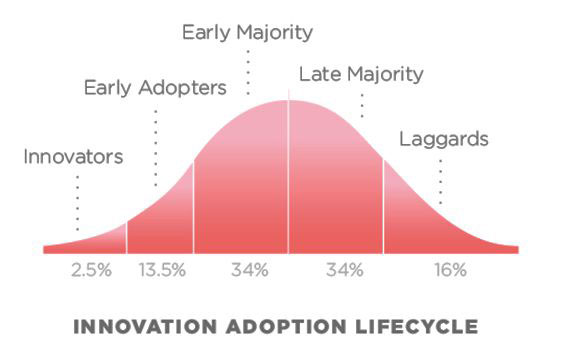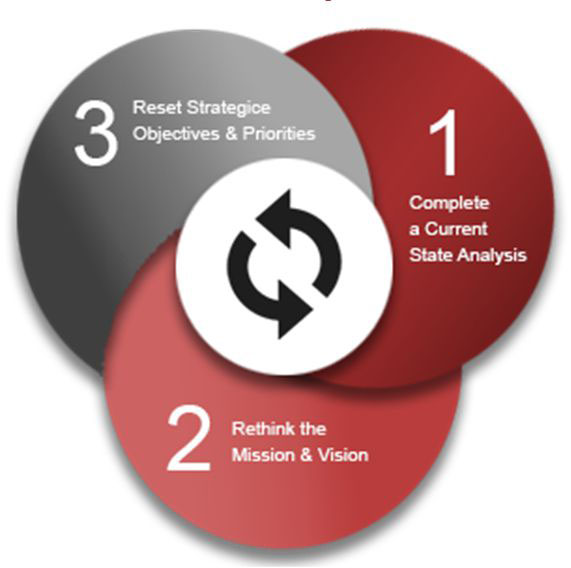THE SHIFT FROM BUSINESS CONTINUITY TO BUSINESS OPPORTUNITY
In the last several months, businesses have been learning to cope in a COVID-19 world out of necessity. Companies have been largely focused on business continuity as leaders develop processes to ensure the safety of their workforce, develop new hiring practices, establish remote-working practices, provide appropriate equipment to work from home or develop new safety practices to bring people back to work on-site, etc. Most leaders have not taken the time needed to step back and rethink their strategy and vision. Leaders will need to step back and rethink the implications of COVID-19 relative to their business strategies. With major companies like Goldman Sachs, Starbucks, Google, and thousands more changing some of their major business practices; when is the last time your leaders met to discuss the strategic implications? We must challenge the leadership team to ask the million-dollar question, “What are the strategic opportunities presented by COVID-19.”

DIFFUSION OF INNOVATION
The diffusion of innovations graph by Everett Rogers, a professor of communications in 1962, could not be more relevant today. You have your early innovators/market leaders, early adopters/fast followers, followed by the early majority, late majority, and laggards who choose to wait and see what happens. Where do you want your organization to be on the curve? By waiting too long to ask the question – you may lose the window of opportunity.
RETHINKING YOUR STRATEGY
WHERE TO BEGIN
One of the difficult challenges about rethinking your strategy is allocating the time to re-evaluate your options. With the multitude of competing priorities, time is often spent reacting to operational issues. While this attention is necessary, it can pull leaders away from the strategic discussions that need to take place. Leaders need to take a step back, reprioritize, and plan to effectively hold strategy sessions. For every 3-4 operational meetings, we believe, on average, there ought to be 1 strategic meeting. Think back to when your last strategic meeting was whether it be at an organizational, department, or staff level. These meetings need to have the full attention of leaders as it is what sets your company apart from competitors. Organizations must start by assembling their teams now. Strategic sessions are not limited to re-forecasting exercises. They also include answering critical strategic questions as a leadership team to arrive at timely decisions that shape the future. Asking these questions now will enable you to get out ahead and be a part of shaping the future state rather than reacting to it.

STEP 1: COMPLETE A CURRENT STATE ANALYSIS/ORGSCAN™
Understanding your current state is the first step in conducting an effective strategic meeting. Give your team pre-work and expect them to think through the strengths, weaknesses, opportunities, and threats to form a SWOT analysis. After your team has examined and prioritized its SWOT analysis, you’ll need to engage your team in a discussion of the:
- Industry Trends
- Market Trends
- Social Trends/Patterns
- Competitive Trends
- Core Competencies
STEP 2: RETHINK THE MISSION & VISION
The business landscape has changed almost everywhere in the world as companies find ways to operate during this period of time. Now, leaders need to revisit the organization’s vision in light of the long-term shifts taking place due to Covid. Think through some of the following questions and dig deep into how they apply to your organization today.
- Do we believe that our vision is achievable given the new shifts in the market, industry and social norms? If the answer is no, how does our vision need to change?
- What new opportunities have surfaced in the marketplace that our core capabilities can capitalize on?
By asking what needs have arisen because of Covid-19, you could very well uncover an untapped need that could leverage your core competencies. Referencing back to the bell-shaped curve, early adopters and frontrunners are the ones who will gain a competitive advantage in the market. Ask the tough question, “What is our unique differentiator and does our value proposition need to change?” Answering this question and laying out a plan will position you at the front end of the innovation curve. Whether you choose to be a market innovator, or an early adopter/fast follower will depend upon your leader’s strategy. The key is that you are taking the time to ask the right questions and making deliberate decisions with your team instead of reacting because you are forced to do so.
STEP 3: RESET STRATEGIC OBJECTIVES & PRIORITIES
You may have planned an office redesign or a technology improvement 3 years from now but given Covid-19’s implications you may choose to revisit these priorities and accelerate the pace of some strategic priorities and delay others. Use the sample questions below as starters to your strategic dialogue.
- How effective is our organization’s delivery model in the age of Covid-19 and beyond?
- How do we need to align our current product/service offering to meet changing market demands?
- How does our recruitment strategy need to change as talent can now live and work from anywhere?
- How easy is it to find and use our online resources?
- How/can we move everything to the cloud?

EFFECTIVE STRATEGY SESSIONS
THE NUTS & BOLTS
Break it Down Into Manageable Segments
What are some of the key decisions you’ll need to explore as a leadership team?
Session 1 can consist of a deep discussion of the SWOT Analysis. By the end of this session, the team will have prioritized the greatest strengths, weaknesses, opportunities and threats facing your business, department or team.
Session 2 can consist of defining your current state and conducting an OrgScan.™ Examine market trends, industry trends, core competencies and social trends affecting your organization. What are the implications of these trends?
Session 3 can center around the vision and whether the vision can remain intact or if it needs to shift in light of the long-term implications of Covid on your organization. Determining the strategic shift required, if at all, is essential to shaping the future instead of reacting to it.
Session 4 can focus on the strategic objectives set in motion to frame the priorities of your organization. How do they need to change, if at all?
Session 5 can explore the strategic priorities/initiatives you will undertake in the next 1-3 years. Do some take on greater importance or less importance in light of Covid?
Session 6 can focus on the operational and communication plans that will require the full alignment of associates to achieve the end objectives.

EXAMPLES
Thousands of companies are already changing the way they think. Multi-billion-dollar companies to small businesses are shifting strategies to meet the needs and shape the future for not just the next year, but for three to five years. A couple of these include Starbucks and Goldman Sachs.
Starbucks:
This coffeehouse chain has recently engaged in a seismic shift in strategy. Originally, Starbucks wanted consumers to think about their cafes as the “3rd place” they want to spend their time. #1 is home #2 is work and #3 is Starbucks. Starbucks vision included creating a coffee house experience where customers would be comfortable spending considerable time in their cafes. In the last few months, social trends have changed, and people have become fearful of entering brick and mortar stores. Some may no longer be interested in spending hours inside the café; therefore the company is accelerating its business strategy to open up hundreds of new drive-thrus.
DRIVING ENGAGEMENT IN MEETINGS
While the strategy had been put in place pre-Covid, the social trends accelerated the timetable for this strategy to be implemented.
Goldman Sachs:
This giant has changed many internal policies including its recruitment strategy/hiring practices. With the shift to working remote, organizations can make deliberate decisions to recruit the best and brightest talent from anywhere given that there may be no restrictions to a geographic location. Goldman Sachs is now conducting interviews that leverage technology. The applicant records the interview “live” as questions are recorded and submitted. The interview process no longer relies exclusively on the in-person experience and allows the company to hire nationally rather than at one location.

BOTTOM LINE
If you think back to your last strategic planning session, what was accomplished? What were the critical decisions reached? Initiating these discussions with your team will help you plan more effectively in times of crisis and stay ahead of the competition. Use this window of time to examine and rethink your strategy so that you may shape the future of your organization.
SUMMARY
- Companies have been largely focused on business continuity during Covid-19. Now, leaders must turn their attention to re-thinking their business strategy.
- New opportunities arise as the market, industry and social trends shift. Leaders can seize upon these opportunities by setting aside time to discuss and agree on their strategic direction.
- Market leaders and innovators will be acting decisively to tackle these challenges and opportunities. Why not you?

FOR MORE INFORMATION
The Executive Edge®, Inc. works in partnership with leaders and their teams across the country to develop and facilitate strategic planning sessions. The end result is a cohesive and well-aligned strategy that serves to focus the energy of the workforce around a common mission, vision, measurable strategic objectives and strategic priorities. We also work with organizations to help them agree on their unique value proposition to differentiate themselves in their respective marketplace.
For more information, visit our website at www.theexecutiveedge.net or call 630-404-2256 to arrange an initial free consultation.


